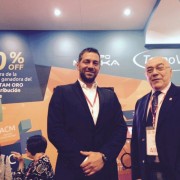Why Internet of Things is the next frontier of customer experience
By Gerardo Andreucci
The fantasy of any customer service professional is to offer an answer even before the customer knows he has a problem. This possibility to react in advance is what makes the Internet of Things (IoT) phenomenon one of the most exciting topics for the contact center industry and the customer experience.
We are a step beyond the omnicanality, whose basic premise is that the customer can access the company easily, from the channel of their preference, at any time and obtain a consistent response. The paradox of this premise is, however, that in most of their contact scenarios, the customer is already dissatisfied or has a problem, and the company is in the position to reverse a generally adverse scenario.
What if we change the focus? What would be the role of the Customer Service Center if its mission was to ensure that the customer never gets to discontent? Moving from reaction to prevention. To ensure that the contact strategy be to avoid the complaint to stimulate propositive contact.
Gartner predicts that by 2020 we will find a scenario with up to 50 0 smart objects in each home collaborating through the Internet of Things. I think organizations should consider how this phenomenon will affect their customer engagement strategies. And they must begin to imagine the tools they can implement to anticipate customers’ needs.
0 smart objects in each home collaborating through the Internet of Things. I think organizations should consider how this phenomenon will affect their customer engagement strategies. And they must begin to imagine the tools they can implement to anticipate customers’ needs.
In general the new technologies related to IoT lead to discussions on their disruptive impact on business models, but a reflection about the changes that they have on customer experiences is not heard so often. From my perspective, these changes are significantly deeper than the impacts on the business models.
In addition, I believe that the shift in focus from a purely technological conception to one involving experience will occur more rapidly in this space than in others. From technology providers, added value will evolve rapidly from selling remote monitoring products to selling solutions for creating and managing new experiences between companies and their customers.
The problem to be solved is how brands can use the existing infrastructure of connected sensors to build better relationships with customers. I imagine several possibilities. From strategies to reward consumers for their time, money, effort and commitment, all derived from the data generated online to improve interaction; To programs aimed at empowering customers to consume more intelligently by using information media designed to assist them in making product and service decisions, precisely when they need it.
The highly distributed companies and the ones with real estate assets could use smart devices connected to video cameras and audio to enable their suppliers to take preventive measures immediately. This would enable them to provide their customers with a high percentage of real-time resolutions, even before those customers have become aware of the problem.
In Japan several companies that have significant challenges in their supply chain, both B2C and B2B, are designing intelligent shelves for the delivery of their products, sending information through the Internet to track the deliveries, the inventory of who accessed. This saves significant costs by not having to maintain multiple inventory items that are never used.
In several markets, telecommunications companies are making their home WiFi routers smarter, so that the service center technicians can proactively diagnose, with alerts triggered when a problem occurs (with the Internet signal, for example), And activate solutions from the support department before the customer finds out.
Mobile applications are also being created to ease the flow of inbound calls to the Support Center. What would happen if these mobile applications also diagnosed the top 10 reasons for support calls?
The challenges are several, in many cases they involve changing contact center workflows. But it is also true that Internet of Things opens the opportunity to generate a real change of game. The first companies to take the initiative will have great advantages, cost reductions, and more importantly, reduced customer turnover rates.









